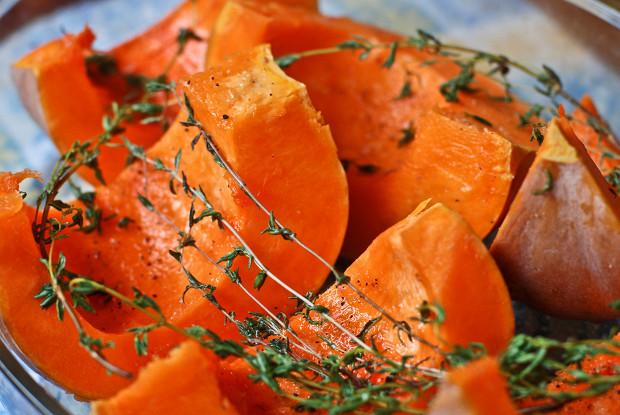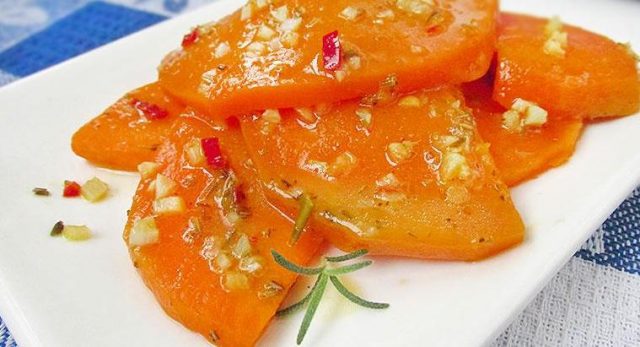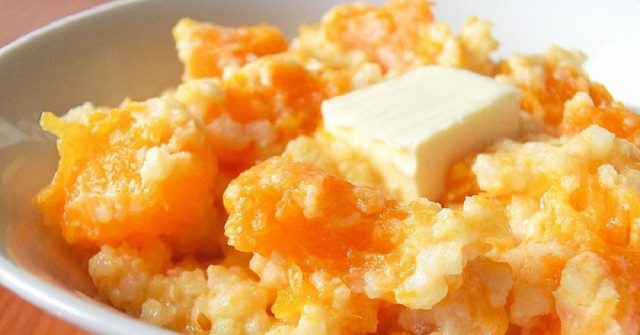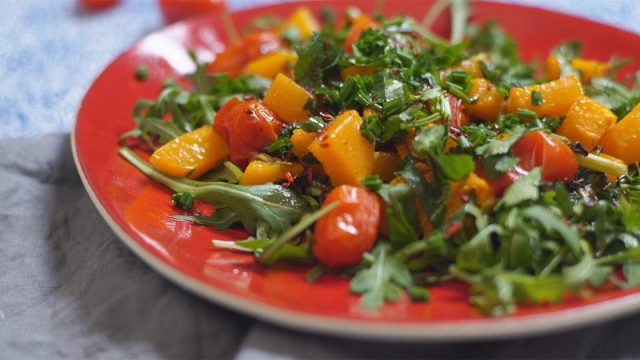Content
Many people know about the excellent taste properties of pumpkin. Appetizing porridge and other dishes made from it are popular among all segments of the population. But not everyone knows that the calorie content of boiled pumpkin can be attributed to dietary products, and the mass of useful properties makes it one of the most useful vegetables.
Nutritional value and composition of boiled pumpkin
Boiled pumpkin owes its many useful properties to its chemical composition. It is a source of various vitamins that humans need. It contains especially a lot of vitamins C and B, on the amount of which the body's immunity and the normal functioning of the nervous system directly depend. It also contains a rare T vitamin that stimulates the production of red and white blood cells. In addition, boiled pumpkin contains PP vitamins, vitamins A and K.
In addition, pumpkin is a rich source of minerals. Iron, copper and cobalt, which are present in the composition of this useful product, are actively involved in the process of hematopoiesis, and magnesium and phosphorus support the optimal functioning of the heart muscle and brain. In addition, the vegetable contains fluoride, potassium and calcium.
How many calories are in pumpkin boiled in water
In addition to its abundant supply of vitamins, pumpkin stands out among other vegetables and other beneficial properties. So, it simultaneously manifests itself as a nutritious and dietary product, since the calorie content of boiled pumpkin per 100 grams is 22 kcal, and if you cook it without salt, then only 20. There are almost no fats in it: their share reaches 0.1 g. the same composition includes water and carbohydrates (92 and 4 g, respectively). This low calorie content makes this product very useful for dieters, as well as for those who monitor their weight.
Glycemic index of boiled pumpkin
You can often hear about the benefits of boiled pumpkin for people with diabetes. This product does have blood sugar-lowering properties, but their effectiveness depends on how the product is processed. Boiled pumpkin, unlike raw pumpkin, has a fairly high glycemic index due to the large amount of fructose and sucrose - 75 units. However, doctors often allow people with diabetes to consume this product in small quantities, taking into account the beneficial effects that it has on the body, in particular on the pancreas. Therefore, before including it in your diet, you should consult with a specialist.
Why boiled pumpkin is useful
The benefits of boiled pumpkin for the human body are difficult to deny. The unique properties of this vegetable have a beneficial effect on the liver, cleansing it of harmful substances and toxins. Fiber in its composition helps to improve the functioning of the intestines and stomach, and in combination with pectin it is able to break down excess fat-containing substances. The anti-inflammatory properties of the vegetable promote enhanced tissue regeneration and wound healing, therefore it is especially recommended for people with diseases of the urinary system.
The beneficial properties of pumpkin make it a perfect product for baby food.The abundance of vitamin A strengthens the defenses of the child's body, reducing its susceptibility to the effects of pathogens and viruses, and, in addition, improves vision. Phosphorus, potassium and B vitamins support healthy bone growth and development, as well as stabilize nervous system functions, which is especially important for preschool children. In addition, the delicate consistency of this healthy product is easily digested and quickly absorbed by the body, which is why it serves as a popular component of mixtures and purees for the first feeding of babies.
Boiled pumpkin is also useful for men. Zinc is present in its pulp, as well as in the seeds, which enhances the production of the male sex hormone testosterone. It, in turn, has a positive effect on potency, improving sperm quality and increasing sexual desire.
Women will also appreciate the health benefits of boiled pumpkin. Thus, vitamin A has a beneficial effect on the condition of the skin, giving it elasticity and restoring a healthy tone. This vitamin will also increase the tanning resistance of all beach lovers and tanning salons.
A large amount of vitamins mitigates the effects of menopause and prevents physical and psychological complications. And the low calorie content and the property of boiled pumpkin to remove toxins and excess fluid from the body make it possible to use this vegetable when drawing up a diet for weight loss.
Why boiled pumpkin is useful for the human body
The beneficial properties of boiled pumpkin can not only prolong human health, but also reduce the symptoms of a variety of diseases. So, it is recommended to add this product to the menu for various ailments:
- Anemia. The pulp of this vegetable contains a lot of iron and other active substances involved in the hematopoietic function of the body, therefore, daily consumption of 40 - 150 g of boiled pumpkin 3-4 times a day can normalize the level of hemoglobin;
- Atherosclerosis. Pectins, which are present in the vegetable, regulate the level of bad cholesterol, and the anti-inflammatory properties of the product reduce pain, which helps to alleviate the symptoms of the disease;
- Swelling in kidney disease. The diuretic properties of the product are able to remove excess fluid from the body and reduce swelling if there is porridge with boiled pumpkin 1 - 2 times a day;
- Caries and other diseases of the oral cavity. The high content of fluoride prevents the development of dental caries and inflammatory processes in the gums. The daily dose of this substance is contained in 500 - 600 g of boiled pumpkin;
- Heart disease. The cardiovascular system can be supported if boiled pumpkin rich in magnesium is consumed in vegetable salads at the rate of 300 - 400 g per day.
How to cook boiled pumpkin properly
To extract the maximum amount of useful properties from pumpkin, you need to be able to cook it correctly:
- Before cooking, you must thoroughly rinse the vegetable, cut it into 2 parts and remove the seeds.
- After that, the product should be peeled. You can use a regular kitchen knife or a saw knife.
- Pumpkin pulp needs to be cut into slices or cubes up to 3 cm in size. It is advisable to wrap the unused part of the vegetable in cling film or foil and put it in the refrigerator. After that, you can proceed directly to cooking.
- You need to put a vegetable in a spacious saucepan and fill it with water so that the water completely hides it.
- As soon as the water boils, it is worth adding salt or other spices as desired, then continue to cook the dish for 25 - 30 minutes over moderate heat.
- You can check the readiness of the product with a plug. If the vegetable is soft, then it should be removed from the heat, then drain the water from the pan and allow the dish to cool.
The finished product can be served with sour cream and herbs as an independent dish or diversified with meat or fish. On the basis of these healthy products, even desserts can be prepared, which not only retain all the properties of pumpkin, but will also please even the most selective eaters.
Dessert is prepared according to the following scheme:
- Washed pumpkin in the amount of 500 g is peeled and cut into large pieces.
- 2 tbsp. water is poured into a saucepan and brought to a boil, then pieces of vegetable are placed in a bowl.
- Fall asleep 6 tbsp. l. sugar and add 1 cinnamon stick.
- Cook for 20 minutes, check for readiness.
- The boiled pumpkin is caught with a slotted spoon and put on the hot, then sprinkled with sugar and allowed to cool.
- Before serving, the dessert is cooled in the refrigerator for 30 minutes.
And if you add millet to boiled pumpkin, you get an appetizing porridge that will be appreciated by both children and adults:
- 500 g of pulp is rubbed on a coarse grater.
- In a saucepan with thick walls, combine 1 tbsp. milk and 2 tbsp. l. butter, then add pumpkin to the mixture and stew for 15 minutes.
- Add 3 tbsp to the vegetable. l. washed millet groats, 1 tbsp. l. honey and salt to taste.
- The ingredients are thoroughly mixed and cooked over low heat, covered with a lid, for 10 minutes.
- The finished porridge is wrapped in a towel and allowed to brew for about 10 minutes.
The beneficial properties of boiled pumpkin will work well in a salad in combination with other vegetables:
- Three hundred grams of washed boiled pumpkin, cut into 1 cm cubes, are spread on a plate.
- Two medium pickled cucumbers are cut into thin strips, 1 tomato is cut into thin slices.
- Half of the onion is washed, peeled and finely chopped.
- Mix vegetables in a deep bowl, add salt and pepper.
- Before serving, the salad is seasoned with 2 tbsp. l. butter, sprinkled with herbs.
Boiled pumpkin also makes healthy first courses, such as puree soup:
- 200 g of pumpkin and potatoes are washed, peeled and finely chopped.
- White crackers, salt and sugar are added to taste.
- Pour the ingredients with water and cook until vegetables are cooked over medium heat.
- Wipe the workpiece through a colander, add 1 tbsp. l. vegetable oil.
- Combine the thick with milk and cook until tender. Decorate with greens.
Limitations and contraindications
Despite all the benefits and unique properties of boiled pumpkin, certain groups of people are advised to refrain from eating it in order to eliminate possible harm to the body. So, the vegetable is contraindicated for people to use:
- with individual intolerance to the product or its components;
- suffering from diarrhea;
- having gastritis with low acidity.
Boiled pumpkin should be eaten with caution by those who suffer:
- diabetes mellitus;
- peptic ulcer of the stomach and intestines.
The aforementioned people can diversify their menu with a small amount of product, but only after consultation with the attending physician has been agreed.
Conclusion
The low calorie content of boiled pumpkin and its properties have made this vegetable very popular among connoisseurs of healthy nutrition. If you follow all the recommendations for use and cooking, this healthy product will not only delight you with excellent taste, but will also prolong your health.














